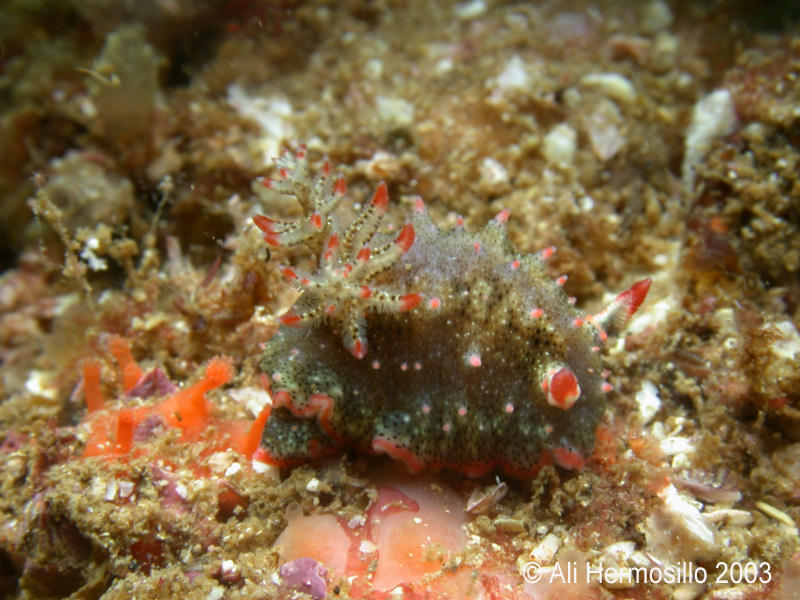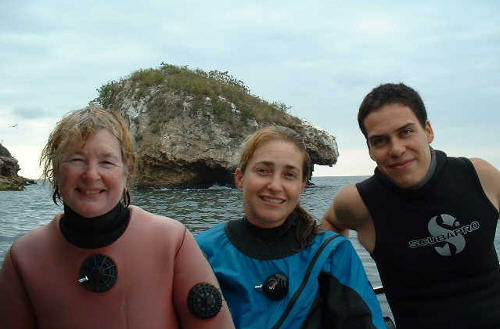 |
Glossodoris dalli
Photos couresty of Ali Hermosillo and Pedro MedinaBanderas Bay, Puerto Vallarta, Mexico
Glossodoris dalli ( (Bergh, 1879)
Glossodoris dalli is a very common dorid found along the outer coast of Baja California Sur, within the Gulf of California all the way south to Panama and Islas Galapagos in Ecuador. It is one of the earliest nudibranchs described for our coast.
The shape of the body is elongated with numerous little rounded tubercules. The overall body color can vary immensely between individuals, from brown, green, gray to blueish in several shades. The ground color is usually white to gray and presents numerous black, brown, greenish, yellow and/or blue blotches and tiny dots. In some animals the base color is observed darker and more concentrated towards the center of the dorsum; others have darker and more concentrated dots towards the notum margin.
Even though Glossodoris dalli has all the previously mentioned color variations, every animal has a few irregularly distributed big orange, red or bright pink spots on the tips of the larger tubercules and an orange, red or bright pink stripe on the edge of the margin as well as the very long tail.
Both the large unipinnate gills and the heavily lamellated rhinophores are the same ground color of the body, turning distally into orange, red or bright pink with a white tip. The color patterns of Glossodoris dalli make it difficult to spot against the background. It is usually seen crawling on walls or large rocks, looking for the encrusting sponges it feeds on, very well concealed by growths such as gorgonians, sea fans, algi and hydroids.
I usually find 10 or so specimens every month of survey in Bahia de Banderas where all the color variations can be observed. Glossodoris dalli lays typical dorid shape white egg masses and the generations most likely overlap.
For those of you on broad band, tune into a short video clip (11 Megs) in Quicktime format filmed by Pedro Medina of this interesting animal.
Puerto Vallarta, Mexico
Oct. 2003
Sandra Millen, Ali Hermosillo, and Pedro Medina
Puerto Vallarta, April 2002

|
Webmaster's Notes: I have always been intrigued with the color variation of Glossodoris dalli as seen in a Nudibranch Calendar produced by long time brancher Jeff Hamann some years ago. The picture was captioned as having been taken at Puerto Vallarta, Mexico. In our travels in the Gulf of California we had yet to see a G. dalli with the blue hue that seems to set Bay of Banderas specimens apart from what is typically seen in the Gulf. Our hats are off to Ali again for making her studies and information available to the rest of us! I would like to take this opportunity to totally endorse the dive operation Ali and Roberto's are associated with
Vallar-Tech in Puerto Vallarta for any nudiphile who would like to experience the Pan American branching scene! Their operation is first class and Ali and associates will certainly find enough branchs to rekindle memories of the trip for years to come. They can arrange hotel accommodations very convenient to the dive operation.
Ali can be contacted at gueri25@hotmail.com |
"...I take pictures with a Nikon Coolpix 995 (3.4 megapixels). For the underwater photos I use an Aquatica housing and a 10 watt HID light. For the tub shots I use a couple of 50 watt cold fiber optic lights and a 5x magnifying glass held in front of the camera lens.
I am in the fourth semester of my Ph.D. I have been surveying Bahia de
Banderas now for 18 months. After the first year I was able to pick 10
sites to visit every month in order to monitor the communities of
opisthobranchs there. In this 18 months of research, my opisthobranch
species count for the bay is 126. I have recorded over 12,000 specimens
with data such as depth, size and substrate among others..."
Puerto Vallarta, Mexico
Oct.. , 2003
